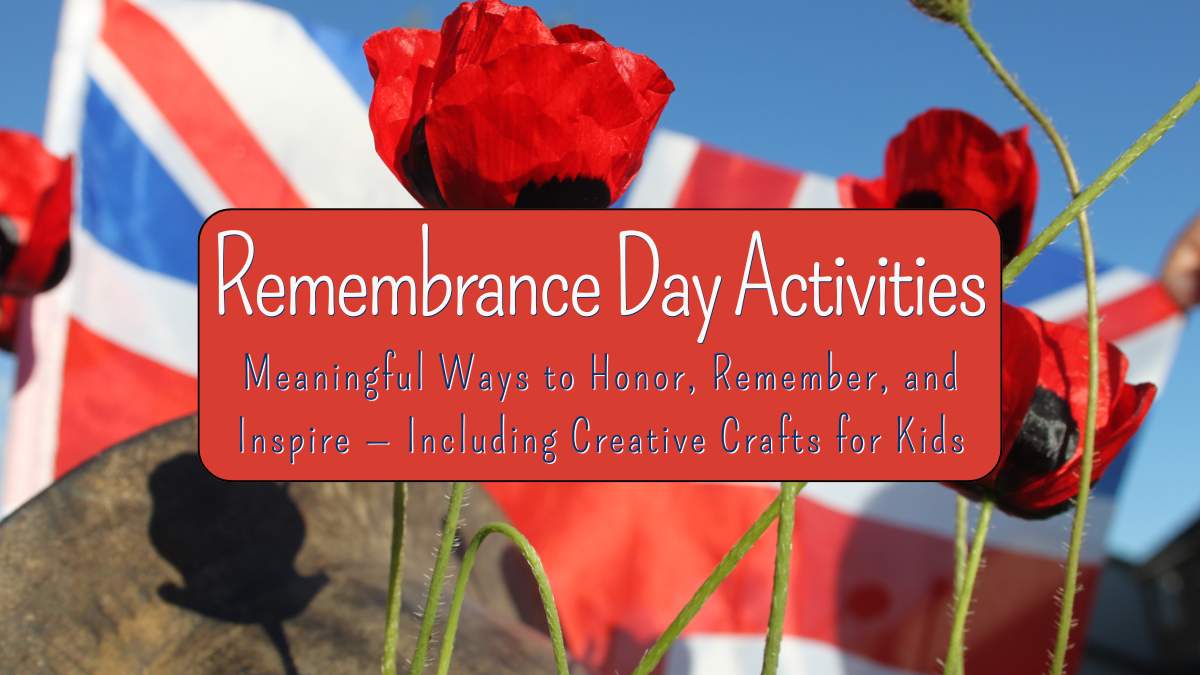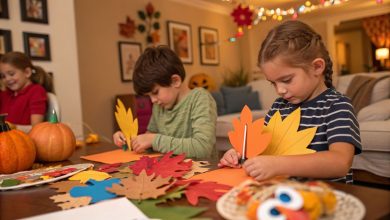Remembrance Day Activities 2025: Meaningful Ways to Honor, Remember, and Inspire — Including Creative Crafts for Kids

Every November, we pause to remember the courage, sacrifice, and resilience of those who served — and what better way to do so than through meaningful Remembrance Day activities? Whether it’s observing a quiet moment of reflection, creating heartfelt crafts, or engaging children in thoughtful discussions, these activities help us connect with the true spirit of the day.
In this post, we’ll explore creative and respectful Remembrance Day activities for kids and families — from simple poppy crafts to school projects and community ideas that spark gratitude and awareness. You’ll find inspiration to make this year’s observance both educational and heartfelt, blending tradition with creativity.
Whether you’re a parent, teacher, or community organizer, these Remembrance Day crafts for kids and group activities will help everyone — young and old — understand the meaning behind the poppy and the power of remembrance. Let’s make Remembrance Day 2025 one to truly remember.
🌺 Understanding the Heart of Remembrance Day
Before diving into creative ideas, it’s essential to pause and reflect on why Remembrance Day matters. Observed on November 11, Remembrance Day (also known as Armistice Day or Veterans Day in some countries) marks the end of World War I in 1918. It’s a day to honor the men and women who served and sacrificed in wars and peacekeeping missions throughout history.
At 11:00 a.m., people across the world observe a two-minute silence to remember those who gave their lives. The poppy, inspired by the poem “In Flanders Fields”, has become the symbol of remembrance — representing both the blood spilled in battle and the resilience of life that blooms after devastation.
Teaching the next generation the meaning of this day ensures that remembrance remains a living act — not just a date on the calendar. That’s why Remembrance Day activities for kids and families are so valuable. They help bridge the past and the present in heartfelt, age-appropriate ways.
Simple Yet Meaningful Remembrance Day Activities
You don’t need elaborate plans or expensive materials to commemorate Remembrance Day. Here are some simple, respectful, and heartfelt activities that families, schools, and communities can easily adopt in 2025.
1. Observe the Two-Minute Silence
Encourage children and adults alike to take part in the 11 a.m. moment of silence. Explain why it matters: it’s not about being still for no reason, but about reflecting on bravery, peace, and gratitude.
You can make it more personal by:
- Reading a short poem before or after the silence.
- Lighting a candle in remembrance.
- Displaying photos of veterans or family members who served.
2. Wear the Poppy with Pride
The red poppy remains the most iconic symbol of remembrance. Wearing one on your jacket, backpack, or hat is a simple yet powerful gesture.
For children, explain what the poppy represents — renewal, hope, and respect. You can even create handmade poppies (more on this in the crafts section below) to help kids feel involved.
3. Visit a War Memorial or Cemetery
If possible, visit a local war memorial, cenotaph, or veteran’s cemetery. Bring flowers, handmade wreaths, or paper poppies to place at the site.
Encourage kids to write a message of thanks on small cards — for instance, “Thank you for your courage” or “We will always remember.”
4. Watch a Remembrance Day Ceremony
Many communities hold ceremonies that are broadcast on TV or online. Watching together helps children understand how widespread the act of remembrance is.
Afterward, talk about what they noticed — the bugle calls, the recitation of “In Flanders Fields,” the military uniforms — and what those symbols mean.
5. Write a Letter to a Veteran
This is one of the most touching Remembrance Day activities for kids. Writing thank-you letters or drawing pictures for veterans is a wonderful way to express gratitude. Schools often organize these letters as part of community outreach.
For example:
“Dear Veteran, thank you for your bravery and for helping keep our country safe. I am learning about Remembrance Day and I will always remember your service.”
Related Article: Best Remembrance Day Quotes to Honor and Reflect
Creative Remembrance Day Crafts for Kids
Crafts are a perfect way for children to engage with Remembrance Day meaningfully. They blend creativity with learning, helping kids express their respect through art. Here are some beautiful and educational craft ideas for classrooms, families, and community programs.
1. Paper Poppy Craft
Supplies: red and black construction paper, scissors, glue, and green pipe cleaners.
Steps:
- Cut four red petals from construction paper.
- Glue them together in a circle.
- Add a small black circle in the center.
- Attach a green pipe cleaner as the stem.
💡 Tip: Turn these poppies into pins, bookmarks, or wreath decorations.
2. Egg Carton Poppies
Supplies: egg cartons, red and black paint, paintbrushes, and green straws.
Steps:
- Cut egg cups from the carton and paint them red.
- Paint a small black dot in the center.
- Glue a green straw to the back as the stem.
These poppies look stunning when arranged in a vase or wreath.
3. Handprint Poppies
Younger kids will love this one!
Supplies: red paint, white paper, black marker.
Steps:
- Paint a child’s hand red and press it on paper.
- Add a black circle in the middle of the palm print.
- Write a short message, like “We Remember” or “Lest We Forget.”
This activity encourages kids to literally leave their mark in remembrance.
4. Remembrance Wreaths
Create a large wreath for your home, classroom, or community space.
Supplies: paper plates, red paper, glue, and ribbon.
Steps:
- Cut the center out of a paper plate to form a ring.
- Glue paper poppies around the edge.
- Add a ribbon and hang it on a door or wall.
This is an ideal group project where each child contributes a poppy to the wreath.
5. “In Flanders Fields” Art Poster
Encourage children to combine art and literature.
Steps:
- Print or write the poem “In Flanders Fields” in the center of a large sheet.
- Decorate with drawings of poppies, fields, and soldiers’ silhouettes.
- Display it in the classroom or a school hallway.
This activity connects art, history, and emotional learning beautifully.
Family Remembrance Day Activities
Commemorating together as a family deepens the understanding of gratitude and service. These ideas bring Remembrance Day activities into the home — where stories and values are shared across generations.
1. Share Family Stories
Ask older relatives if they have memories or family connections to wartime service. Children love hearing real-life stories — they make history feel personal and alive.
You could create a family memory box with photos, medals, letters, or notes that honor those who served.
2. Watch an Educational Documentary or Film
Choose age-appropriate documentaries or movies about peace, courage, and history.
For example:
- The Red Baron (for older kids)
- Anzac Girls or War Horse
- Short animated history videos for younger audiences
After watching, discuss the main lessons — bravery, teamwork, and hope.
3. Bake Remembrance-Themed Treats
Get creative in the kitchen with red-and-black poppy cookies or cupcakes decorated with icing poppies.
You can also make wartime recipes, such as ANZAC biscuits or simple ration-era treats, to help kids understand life during the war years.
4. Decorate Your Window or Porch
Create a Remembrance display with poppy art, red lights, or posters that say “Lest We Forget.”
In recent years, families across neighborhoods have joined together by displaying poppies on windows to create a collective tribute — even from home.
5. Read Together
Reading books about peace and remembrance helps spark conversations. Great options include:
- A Poppy Is to Remember by Heather Patterson
- The Enemy: A Book About Peace by Davide Cali
- Proud as a Peacock, Brave as a Lion by Jane Barclay
Classroom and School Activities for Remembrance Day
Teachers play a huge role in shaping how children understand remembrance. These classroom-friendly Remembrance Day activities combine learning with empathy.
1. Host a School Assembly
Invite students to participate in a Remembrance ceremony with readings, songs, and a moment of silence.
Include performances of “In Flanders Fields” or display student artwork about peace.
2. Write Peace Poems
Encourage students to express what peace means to them through poetry.
Prompts like “Peace looks like…” or “If I could thank a soldier…” help children articulate their thoughts creatively.
3. Timeline of Service
Create a classroom timeline of major global conflicts and peacekeeping missions.
Add photos, newspaper clippings, or personal connections. This helps students see how remembrance is an ongoing story, not a historical footnote.
4. Classroom Poppy Garden
Have each student make one paper poppy and plant it in a sandbox or foam base in the classroom.
Label each poppy with a word such as honor, peace, bravery, or hope.
5. Letters of Thanks
Partner with a local veterans’ organization to deliver handwritten letters from students.
This teaches gratitude in action and makes the day’s lessons tangible.
Community and Group Activities
Beyond the home and classroom, Remembrance Day 2025 is an opportunity for communities to come together in reflection and solidarity.
1. Organize a Local Poppy Walk
Host a community walk where participants wear poppies and visit memorial landmarks.
You can include reading stations with facts, poems, or veteran stories along the route.
2. Community Art Project
Work with local schools or art clubs to create a large poppy mural or mosaic.
Display it in a public area like a library, park, or town hall.
3. Remembrance Candlelight Vigil
Invite families to gather for an evening vigil with candles, music, and reflection.
You can have children read poems or sing peace-themed songs.
4. Fundraise for Veterans
Encourage community fundraising through bake sales, craft fairs, or donation drives.
Funds can support organizations like the Royal Canadian Legion or other local veteran services.
5. Community Reading of “In Flanders Fields”
Gather in a public space and have volunteers of different ages read verses from the famous poem.
It’s a touching, inclusive way to connect all generations in remembrance.
Educational and Reflective Projects
To make remembrance more meaningful, combine hands-on activities with deeper learning projects.
1. Research a Local Hero
Encourage older students or families to research someone from their town who served in the military.
They can present their findings through posters, short essays, or digital slideshows.
2. Memory Stones
Have participants paint small stones with poppies or messages like “Thank You” and place them at local memorials or veterans’ graves.
3. Remembrance Collage or Scrapbook
Collect newspaper clippings, photos, and quotes about peace and service.
Arrange them into a scrapbook that grows each year, documenting your community’s remembrance efforts.
4. Peace Garden
Dedicate a corner of your school or community park as a peace garden, planting poppies, roses, or wildflowers.
Include a small sign or plaque honoring those who served.
5. Virtual Tributes
In 2025, many communities also share remembrance online.
Create digital slideshows, social media posts, or short videos that showcase artwork, crafts, and family reflections — keeping remembrance visible even in the digital space.
Encouraging Reflection and Gratitude
Beyond crafts and ceremonies, Remembrance Day is about understanding. Use quiet reflection and conversation to help children and adults internalize its values.
Questions to Discuss:
- What does peace mean to you?
- Why is it important to remember those who served?
- How can we show gratitude to veterans today?
- What can we do to promote peace in our daily lives?
Encouraging these discussions helps transform remembrance from a passive act into an active value system — one that fosters empathy, kindness, and awareness.
Global Remembrance Traditions
While Remembrance Day originated in the Commonwealth, nations worldwide have their own ways of honoring service. Sharing these helps children appreciate how remembrance unites humanity.
- United Kingdom: National services at the Cenotaph in London and the Royal British Legion’s Poppy Appeal.
- Canada: Ceremonies at the National War Memorial in Ottawa, with poppy distributions across the country.
- Australia & New Zealand: ANZAC Day (April 25) complements Remembrance Day, with dawn services and marches.
- United States: Veterans Day on November 11 celebrates the service of all military veterans.
- France & Belgium: Ceremonies at historic battlefields like Ypres and Verdun.
Understanding these traditions helps children realize that remembrance is a global act of respect — one that transcends borders and generations.
Tips for Making Remembrance Day Activities More Meaningful
- Keep It Age-Appropriate – Tailor activities to your child’s level of understanding. Use simple language for younger kids and more historical context for teens.
- Focus on Hope, Not War – Emphasize peace, courage, and kindness over violence or conflict.
- Incorporate Reflection – Always include a moment of silence, a question to discuss, or a story to share.
- Encourage Participation – Let kids make choices: which craft to do, what to write, or who to thank.
- Connect to Today – Discuss how lessons from history can inspire compassion and peace now.
Keeping the Spirit Alive All Year
Remembrance doesn’t have to end on November 11. Carry its spirit throughout the year with small gestures:
- Visit veterans during holidays.
- Support local charities for military families.
- Display poppy art at home or school year-round.
- Talk about peace during classroom lessons or family dinners.
By weaving remembrance into daily life, we ensure that the sacrifices of the past continue to guide our future.
Final Thoughts,
Honoring those who served doesn’t have to be complicated — even small acts of remembrance carry deep meaning. The Remembrance Day activities shared here invite families and classrooms to reflect, create, and connect through compassion. Whether you choose to make Remembrance Day crafts for kids, write thank-you notes to veterans, or join a local ceremony, every action helps keep history alive.
You don’t need a big budget or elaborate plans — just a little time and heart. Use these ideas to inspire your own traditions, share stories, and help children understand why we remember. Let’s continue to honor the past while shaping a more peaceful future together. 🌺
👉 Ready to start? Try one of these simple remembrance crafts or plan a family reflection activity this week.





